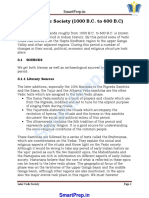GUNAS
GUNAS
Uploaded by
Prasoon KumarCopyright:
Available Formats
GUNAS
GUNAS
Uploaded by
Prasoon KumarCopyright
Available Formats
Share this document
Did you find this document useful?
Is this content inappropriate?
Copyright:
Available Formats
GUNAS
GUNAS
Uploaded by
Prasoon KumarCopyright:
Available Formats
GUNAS
The Gunas, Attributes of Life
http://www.floridavedicinstitute.com/ The Sanskrit word guna means attribute. These attributes serve as a powerful indicator and formulator of the physical principles of the earth. The concept of guna, is one of the more important teachings from India. These attributes provide powerful insight into our spiritual growth, worldly manifestations, and the formation of matter from the subatomic level into more dense levels of matters manifestation. But most importantly they provide a powerful tool to accelerate personal and planetary transformation. Within the yoga tradition, the focus is on three primary gunas: 1. Sattva 2. Rajas 3. Tamas Sattva is balance, harmony, peace and similar qualities. Rajas is activity and movement. It is dynamic. Tamas is inertia, non-moving, and sometimes lethargy. Of these three gunas yoga embraces the cultivation of sattva. Though it realizes that one may embrace other gunas at times. As an example, if a person were stuck in a rut (tamas) they would need to embrace some form of activity (rajas) to move from their position of immobility. Our society is largely a tamasic-rajasic society. We are on the move, active, dynamic, and changing, but at the same time moving very slowly spirituality, and consumed by decay oriented activities. While this is not initially a problem as life is a journey, it is leading to a variety of disorders due to over work, and various strains on our nervous system. Even our yoga systems are often more Rajasic than Sattvic. These are the more dynamic yogas common in western society. These are systems such as the power yoga systems, some kundalini systems, and various aerobic type yogas. Though they clearly serve their purpose. They importantly and primarily serve two types of people: 1) Lethargic or tamsic people that require the intense activity to help them break free from their daily patterns. 2) Rajasic people that are stimulated, active, and dont know how to slow down. This can eventually become unbalancing to this group of people unless it is tempered with relaxing meditation.
While this rajasic yoga is initially important for these two groups of people, it is often overlooked that they must eventually embrace a more sattvic approach to their yoga practice. In the yoga and ayurvedic tradition, everything is made up of complex interaction between the three gunas. This leads to several basic guna types: 1. 2. 3. 4. 5. 6. 7. Rajasic/Sattvic Sattvic Rajasic Tamasic Sattva/Rajasic Rajasic/Tamasic Tamas/Rajasic
Numbers 4-7 indicates complex interactions between the gunas involved. As an example, someone might be very active and dynamic, but they may begin to experience more balance within their life. The ratios between rajas and sattva would change over time as they grew as a person. These gunas and complex interactions between gunas would be applied to all manifestations in life. In an over simplification, a whitewater river would be rajasic, but the erosion would be tamasic or decaying for the banks of the river. In other parts of the river it would be balancing by building up sand bars. The foods we eat are considered balancing (sattvic), stimulating (Rajasic), or decaying (tamasic) to the body and mind. The entire science of Ayurveda is built around this basic concept. To explore these concepts more, it is highly recommended to read Ayurveda and the Mind by Dr. David Frawley. Serious practitioners of spirituality should develop a solid and expansive understanding of the gunas and their application to all facets of life. They should consciously apply this science to all actions and interactions in their daily life. This will reinforce the appropriate gunas within ones spiritual life; and in reality this is what each of does through habit whether we are conscious of it or not. The root to Guna is Grah which means to seize, additionally it means a thread or strand. It seems that on a more mystical level the Nirguna is the absence of this thread or impersonal deity and Saguna is the presence of the thread, which is the personal deity. And of course the thread is the same material as the non-thread from a non-dualistic standpoint, as the material (thread) in a static state becomes dynamic and leads to the creation of the thread. It seems that this thread concept permeates Hinduism from yoga through Nyaya philosophy and numerous other writings. It is the thread that links the lower mind with the infinite essence. Other views toward Gunas. Within the Nyaya system, a system of logic in India, they teach that all created things contain a property-called a guna. Instead of just three they associate twenty-four attributes (gunas) with creation. These twenty-four are in reality complex combinations of the three traditional gunas.
These are: 1. Shape or color (Rupa) 2. Taste (Rasa) 3. Odor (Gandha) 4. Tangibility (Sparsha) 5. Number (Samkhya) 6. Dimension (Parimana) 7. Severalty (Prithaktva) 8. Conjunction (Samyoga) 9. Disjunction (Vibhaga) 10. Remoteness (Paratva) 11. Proximity (Aparaiva) 12. Weight (Gurutva) 13. Fludity (Dravatva) 14. Viscidity (Sneha) 15. Sound (Shabda) 16. Knowledge (Buddhi) 17. Pleasure (Sukha) 18. Pain (Dukha) 19. Desire (Iccha) 20. Aversion (Dvesha) 21. Effort (Prayatna) 22. Merit (Dharma) 23. The self (Samskara) While these can easily apply to all living beings, what is most interesting is that various combinations of these gunas appear in a variety of texts. Pleasure and pain are an important theme in the Yoga sutras of Patanjali. Iccha is an important teaching in Kashmire Shaivism, and is part of the 36 elements of Shaivism. Iccha also appears frequently within the Shiva Sutras. Rasa makes up an important teaching in ayurveda, as taste can aid in increasing or decreasing a dosha. Sound or Shabda makes up the field of mantric yoga. Om being one of the ultimate sounds, the sound behind all sounds. The remaining terms commonly appear within a variety of systems, and it is common for many of these about qualities to appear within the same system. Ayurveda and the gunas. The writings on Ayurveda and the gunas are quite extensive and the gunas are a very important principle within Ayurveda. While many Ayurvedic practitioners may be familiar with the basic concepts of the gunas, and many may even be aware of the gunas manifesting on a mental level as well. Fewer will be aware of the expansive view of gunas within the mental field. Within Ayurveda, guna is commonly used to identify different mental types. These types are identified due to particular activities and mentalities that clearly identify the guna. These are identified as 16 primary types, though again; there can be dual guna types.
TRI-DOSHA GUNA TYPES SATTVA 1. Brahma-(The traits of Brahmaa)
1. Purity, Love for truth, self controlled 2. Power of discrimination, spiritual and material knowledge 3. Power of talk, answering and memory 4. Freedom from passion, anger, greed, ego ignorance, jealousy, dejection and intolerance 5. Favorable disposition equally
2. Aarsha-(The traits of Rshishi)
1. Devotion to sacred rituals, study, vows, celibacy 2. Hospitable disposition 3. Freedom from pride, ego, attachment, hatred, ignorance, greed and anger 4. Intellectual excellence and eloquence 5. Power of understanding and retention
3. Yaamya-(The traits of Yama)
1. Observance of actions (being here in the moment) 2. Initiation of actions in time (ability to time actions for the proper moment) 3. Non-violability 4. Readiness for initiating action 5. Memory 6. Freedom from attachment, envy, hatred and ignorance
4. Aindra-(The traits of Indra)
1. Authoritative speech 2. Performance of sacred rituals 3. Bravery, strength and splendor 4. Freedom from mean acts 5. Far sightedness 6. Devotion to virtuous acts, earning of wealth and proper satisfaction of desires
5. Vaaruna-(The traits of Varuna)
1. Bravery, patience, purity and dislike for impurity 2. Observance of religious rites 3. Fondness for aquatic sports 4. Aversion for mean acts 5. Exhibition of anger and pleasure in proper place
6. Kauvera-(The traits of Kauvera)
1. Possession of station, honor, luxuries and attendants 2. Constant liking for virtuous acts, wealth and satisfaction of desires 3. Purity 4. Liking for pleasures of recreation
7. Gandharva-(The traits of Gandharva)
1. Fondness for dancing, singing, music and praise 2. Expert in poetry and stories 3. Constant fondness for scents, garlands, association of women and passion
RAJAS 1. Aasura-(Titan like)
1. Bravery, cruelty, envy, movement in disguise, terrifying appearance, ruthlessness 2. Indulgence in self-praise
2. Raakshasa-(The traits of Raakshsa-demon)
1. Intolerance, constant anger, violence at weak points, cruelty, gluttonous habits and fondness for non-vegetarian food 2. Excessive sleep and indolence 3. Envious disposition
3. Paishaaca-(The traits of Paishaaca-demonical)
1. Gluttonous habits 2. Fondness for women 3. Liking for staying with women 4. Cowardice and terrifying disposition 5. Abnormal diet
4. Saarpa-(The traits of Sarpa-Snake)
1. Bravery when in wrathful disposition, cowardice when not in wrathful disposition 2. Sharp reaction 3. Excessive indolence 4. Walking, taking food and resorting to other regiments with a fearful disposition
5. Praita-(The traits of Preta-to die)
1. Excessive desire for food 2. Excessively painful disposition
3. Enviousness 4. Actions without discrimination, excessive greediness and inaction
6. Shakuna-(The traits of Shakuna-Bird)
1. Attachment with passion, excessive food and regiment, unsteadiness, ruthlessness and unacquisitiveness
TAMAS 1. Paashava-(The traits of an animal)
1. Forbidding disposition 2. Lack of intelligence (intelligence for right action) 3. Hateful conduct 4. Food habit
2. Maatsya-(The traits of fish)
1. Cowardice, lack of intelligence, greediness for food, unsteadiness, constant passionate and wrathful disposition 2. Fondness for constant movement, desire for water
3. Vaanaspatya-(The traits of vegetables)
1. Indulgence in food, deficiency of all intellectual faculties
The dual types are most prevalent when a person is crossing from one guna group to another. As an example, a Shakuna/Paashvaperson may be difficult to discern or they may cross back and forth between the Rajasic and tamasic quality, as they are transiting from one type to the other over time. Likewise with a guna group you may find combinations such as a Rakshaa/Paishaaca person. And of course in the multi-color tapestry of life, there can be individuals that are oriented toward combinations that appear more removed from one another. As an example, one might encounter an aasura that is also prone to sarpa characteristic. Their dominant field is Rajas, but they are moving back and forth between individual gunas. The previous groupings (tri-dosha guna types) can allow one to fine-tune the guna or combinations of gunas that re most prominent within a person. They should not be used in judgmental way, but as way to identify the forces currently at work or dominant within a person. This can allow for Ayurvedic or Astrological remedials to be tuneed specifically toward the individual. Though in reality most people looking for help would be of a Rajasic, Rajas/Sattva, or Sattvic guna type. Though again exceptions to the rule do exist. Conclusion.
The word guna appears in numerous important texts such as the Bhagavad Gita. The fourteenth chapter is almost completely dedicated to the gunas. The term Guna is an important part of Ayurveda giving it a powerful link to the Vedas. Though the Vedas themselves do mention the word Guna. Guna also appears in the Vedanta system. They also appear in the Yoga sutras of Patanjali. The gunas are also a part of Vedic astrology and other important spiritual systems and traditions. Whether modern science recognizes it or not, our modern chemistry is largely based on the interactions between the gunas. As often in chemistry one is looking to stabilize, make active, or inactivate some chemical or biological action. Gunas are an important and functioning part of every persons physical and spiritual life. They are active and at work whether they are recognized or not. By understanding this powerful force of creation, a student can greatly accelerate their spiritual growth. In the final stages of spiritual realization some believe that you go beyond the gunas, though this happens only for a very few extremely advanced aspirants. For the majority of students, the right application and understanding of the gunas is a critical step toward self-realization and enlightenment. For those few aspirants that have passed beyond the gunas, commonly called the spiritually realized or enlightened; the Bhagavad Gita provides insight by saying, He does not avoid light, activity, or illusionhe remains disinterested or unmoved by the qualities of nature. (14.22)
You might also like
- The Cult of The Black Cube by Arthur MorosDocument84 pagesThe Cult of The Black Cube by Arthur Morosfleurkamijo100% (5)
- Prophecies of Indian Sage - Shri Veera Brahmam GaruDocument76 pagesProphecies of Indian Sage - Shri Veera Brahmam GaruPrasoon Kumar88% (17)
- Yoga and Ayurveda - The Sciences of Self-Realization and Self-HealingDocument1 pageYoga and Ayurveda - The Sciences of Self-Realization and Self-HealingNaveen KumarNo ratings yet
- Panch Prana TableDocument1 pagePanch Prana TableSubramanya Seshagiri100% (1)
- Yoga Sutras of Patanjali: An OverviewDocument17 pagesYoga Sutras of Patanjali: An Overviewbalayogi16100% (2)
- The Meaning of KriyaDocument3 pagesThe Meaning of Kriyasydneypsd100% (1)
- Swami Sivananda Health and Hatha YogaDocument409 pagesSwami Sivananda Health and Hatha YogaPaulo CondesNo ratings yet
- Yoga Kundalini UpanishadDocument29 pagesYoga Kundalini UpanishadThirunavukkarasu100% (5)
- The Heart of The Yogi (Fragment)Document4 pagesThe Heart of The Yogi (Fragment)Alex Rivera100% (1)
- The Aquarian Sadhana - 3HO FoundationDocument8 pagesThe Aquarian Sadhana - 3HO FoundationNicole HawkinsNo ratings yet
- Introduction To Indian MusicDocument7 pagesIntroduction To Indian MusicAlex_musicianNo ratings yet
- Charge of The GoddessDocument4 pagesCharge of The GoddessJohn Smith100% (1)
- Shadow Court PDFDocument129 pagesShadow Court PDFMariangela Xmazizar Bogga Puffungà80% (5)
- Raja Yoga - Yoga as Meditation: Educational yoga books, #2From EverandRaja Yoga - Yoga as Meditation: Educational yoga books, #2No ratings yet
- The GunasDocument24 pagesThe Gunasgladiola1No ratings yet
- Hatha YogaDocument4 pagesHatha YogaantoniocsjNo ratings yet
- Maharishi Vedic Architecture Vāstu For Well Being and SecurityDocument55 pagesMaharishi Vedic Architecture Vāstu For Well Being and SecurityEdryne MarshallNo ratings yet
- Chakra Handout RevisedDocument14 pagesChakra Handout RevisedJessica RossNo ratings yet
- David Frawley - Wikipedia, ..Document7 pagesDavid Frawley - Wikipedia, ..LakshmiPriyaNo ratings yet
- Yogi Gupta Society Newsletter 2015 Winter IssueDocument15 pagesYogi Gupta Society Newsletter 2015 Winter Issuesupershaman100No ratings yet
- Yoga SutrasDocument11 pagesYoga Sutrassatya narayan mahawarNo ratings yet
- Yogashayan Sanskrit Asanas Names ListDocument4 pagesYogashayan Sanskrit Asanas Names ListAnkitNo ratings yet
- Ayurveda Notes 052716Document12 pagesAyurveda Notes 052716api-306206773No ratings yet
- Yoga On Stone' Sculptural Representation of Yoga OnDocument20 pagesYoga On Stone' Sculptural Representation of Yoga OnkellybrandNo ratings yet
- Ajapa Japa - Intuitive Flow PDFDocument5 pagesAjapa Japa - Intuitive Flow PDFKanagu RajaNo ratings yet
- Meditation: Mayur M. Bagaitkar S.Y.C (Bvcoa) - Sem3Document8 pagesMeditation: Mayur M. Bagaitkar S.Y.C (Bvcoa) - Sem3Mayur BagaitkarNo ratings yet
- Who Is A GuruDocument19 pagesWho Is A GuruUday DokrasNo ratings yet
- Mudras of Kndalini YogaDocument2 pagesMudras of Kndalini YogaRomanoJovanovicNo ratings yet
- Three GunasDocument10 pagesThree Gunasmaroli_yogeshNo ratings yet
- Opening of Chakras and MudrasDocument3 pagesOpening of Chakras and Mudraspatil_goa100% (1)
- Ashtanga Vinyasa YogaDocument7 pagesAshtanga Vinyasa YogaRishikhantNo ratings yet
- Ghosts From The Perspective of Jyoti ADocument6 pagesGhosts From The Perspective of Jyoti Asurinder sangarNo ratings yet
- The Yogis Latest TrickDocument26 pagesThe Yogis Latest Trickའཇིགས་བྲལ་ བསམ་གཏན་No ratings yet
- Isha Upa YogaDocument2 pagesIsha Upa YogaJef BarrettNo ratings yet
- OmkarDocument6 pagesOmkarsam2earn100% (1)
- Yogasutras of PatanjaliDocument157 pagesYogasutras of Patanjalishriram100% (1)
- Aquarian Sadhana Mantras Step by StepDocument2 pagesAquarian Sadhana Mantras Step by Stepambsofia5952No ratings yet
- The Power of Prana Nagendra H R - Int J YogaDocument3 pagesThe Power of Prana Nagendra H R - Int J Yogamilind100% (1)
- Jason Birch Namarupa Spring Issue 2015 Yogataravali PDFDocument7 pagesJason Birch Namarupa Spring Issue 2015 Yogataravali PDFletusconnect100% (1)
- Yoga Darshan Vision of The Yoga Upanishads B01jpe7uhcDocument3 pagesYoga Darshan Vision of The Yoga Upanishads B01jpe7uhcgompri100% (1)
- Handy Book of Meditations EbookDocument103 pagesHandy Book of Meditations EbookAmisha ThakkarNo ratings yet
- Aquarian Sadhana MantrasDocument2 pagesAquarian Sadhana MantrasAnanda Kaur0% (1)
- Balancing Prana Vayu and Apana Vayu - SivaSaktiDocument6 pagesBalancing Prana Vayu and Apana Vayu - SivaSaktisugumarjeNo ratings yet
- Whicher - Nirodha Yoga Praxis MindDocument67 pagesWhicher - Nirodha Yoga Praxis MindCharlie HigginsNo ratings yet
- Mudra VigyanDocument9 pagesMudra VigyanFaizul HaqueNo ratings yet
- The IndriyasDocument4 pagesThe IndriyasRajeswari Ranganathan100% (1)
- Guru Nanak and The Yogis - 3HO Kundalini Yoga - A Healthy, Happy, Holy Way of Life PDFDocument4 pagesGuru Nanak and The Yogis - 3HO Kundalini Yoga - A Healthy, Happy, Holy Way of Life PDFRamjoti KaurNo ratings yet
- Yoga Makaranda KrishnamacharyaDocument169 pagesYoga Makaranda KrishnamacharyacaduceosNo ratings yet
- Manipūra ChakraDocument18 pagesManipūra ChakraDragan SokolovskiNo ratings yet
- Kleshas of Yoga Versus Kleshas of Ayurveda - Study AyurvedaDocument2 pagesKleshas of Yoga Versus Kleshas of Ayurveda - Study AyurvedaMatt AldridgeNo ratings yet
- Yoga - Prana Vayu - Five Vital ForcesDocument5 pagesYoga - Prana Vayu - Five Vital ForcesSuresh IndiaNo ratings yet
- Deviyoga PDFDocument9 pagesDeviyoga PDFpsush15No ratings yet
- Yoga SutrasDocument239 pagesYoga Sutrasbalamohanant100% (2)
- Pancha Koshas-By Swami NiranjananandaDocument4 pagesPancha Koshas-By Swami Niranjananandatsudhakar99100% (1)
- Yoga Open NotesDocument8 pagesYoga Open NotesInsight MndyNo ratings yet
- 06 Ashtanga Yoga Series1 IyengarDocument1 page06 Ashtanga Yoga Series1 IyengartokabiNo ratings yet
- Tantra YogaDocument7 pagesTantra Yogahiren1206No ratings yet
- Yoga Routine Sun & Monn SalutationsDocument5 pagesYoga Routine Sun & Monn SalutationsBeyond MedicineNo ratings yet
- Yoga Sutras - An IntroductionDocument7 pagesYoga Sutras - An IntroductionAnkit100% (1)
- Arthur Avalon - Shakta and ShaktiDocument370 pagesArthur Avalon - Shakta and ShaktirelristeinNo ratings yet
- Living With Stress Without Distress Through Yoga: Stress Management Modern And Yogic Perspective (An Overview)From EverandLiving With Stress Without Distress Through Yoga: Stress Management Modern And Yogic Perspective (An Overview)Rating: 5 out of 5 stars5/5 (1)
- DEVROI-2.1 - Indian SymbolsDocument33 pagesDEVROI-2.1 - Indian SymbolsPrasoon KumarNo ratings yet
- CCB2011 Information Brochure 09-06-2011 FINAL VersionIDocument98 pagesCCB2011 Information Brochure 09-06-2011 FINAL VersionIanon_315434879No ratings yet
- CCB2011 Information Brochure 09-06-2011 FINAL VersionIDocument98 pagesCCB2011 Information Brochure 09-06-2011 FINAL VersionIanon_315434879No ratings yet
- World Youth Day Brazil: ChristDocument11 pagesWorld Youth Day Brazil: ChristChrist the KingNo ratings yet
- The Legend of The Oruro CarnivalDocument1 pageThe Legend of The Oruro CarnivalAndrés Mirosevic KollerNo ratings yet
- Ethical Importance of Yama and NiyamaDocument3 pagesEthical Importance of Yama and Niyamadeepa duttaNo ratings yet
- Ccs - Kapampangan Part 1Document44 pagesCcs - Kapampangan Part 1Isa EcarwanNo ratings yet
- Maislap Seventh Day Adventist ChurchDocument6 pagesMaislap Seventh Day Adventist ChurchReynald TayagNo ratings yet
- Otonen OnADocument54 pagesOtonen OnATravis Frazier100% (1)
- Who Is Marrying - The PriestDocument12 pagesWho Is Marrying - The PriestGeeJayNo ratings yet
- Tithis and Yogas PDFDocument5 pagesTithis and Yogas PDFSubir DasNo ratings yet
- Later Vedic Period and SocietyDocument13 pagesLater Vedic Period and SocietyTanu Rd0% (1)
- Answers 2Document4 pagesAnswers 2kalamnafisat2023No ratings yet
- Festivals of BengalDocument14 pagesFestivals of Bengalvarun prajapati100% (1)
- SkadeDocument1 pageSkadeKris DunnNo ratings yet
- Salvation - Langston HughesDocument2 pagesSalvation - Langston Hughesapi-277424446No ratings yet
- Altar Servers GuideDocument11 pagesAltar Servers GuideJan Pierre Pizarro0% (1)
- Plato Laws Book 5Document15 pagesPlato Laws Book 5Leon LerborgNo ratings yet
- Abiding in ChristDocument4 pagesAbiding in ChristRob CallisonNo ratings yet
- Spiritual Authority & CoveringDocument2 pagesSpiritual Authority & CoveringHarVyNo ratings yet
- Thomas Moore - Candle Magick For Love cd2 Id1253388733 Size28 PDFDocument3 pagesThomas Moore - Candle Magick For Love cd2 Id1253388733 Size28 PDFtracy1765No ratings yet
- Strange Rituals of IndiaDocument12 pagesStrange Rituals of IndiaAshutosh RaiNo ratings yet
- Unisystem - Dresen FilesDocument14 pagesUnisystem - Dresen FilesWilliam Myers100% (3)
- Concept of Worship in Islam and HinduismDocument8 pagesConcept of Worship in Islam and Hinduismsaadi733No ratings yet
- Setite Sorcery 5.0Document37 pagesSetite Sorcery 5.0theevilstNo ratings yet
- Be of Good CourageDocument3 pagesBe of Good CourageKathleenNo ratings yet
- Mantra LinksDocument5 pagesMantra LinksBramNo ratings yet
- Rituals Associated With Water Structures, Water BodiesDocument22 pagesRituals Associated With Water Structures, Water Bodiesshivanjali maneNo ratings yet
- Cornerstone (G) Always (Key of G) Your Glory (Key of D)Document1 pageCornerstone (G) Always (Key of G) Your Glory (Key of D)Chadly307No ratings yet




























































































